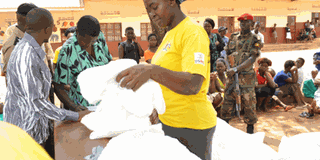Government to save Shs250 billion on malaria

Women wait to receive mosquito nets during a distribution exercise at St Martin Primary School in Mulago, a Kampala suburb yesterday. PHOTO BY RACHEL MABALA.
What you need to know:
Malaria kills at least 80,000 people in Uganda annually, according to the Ministry of Health.
KAMPALA- Following the completion of the distribution of treated mosquito nets across the country, the Minster for Health, Dr Ruhakana Rugunda, has said government will save more than $100m (Shs250b) if they are properly used.
Dr Rugunda was speaking at the launch of the last phase of the mosquito nets distribution campaign in Kampala at the weekend.
He said malaria-related deaths and illness will be reduced substantially; as well the amount of money government spends on malaria treatment annually.
Malaria takes the biggest percentage of the Ministry of Health budget, according to Dr Rugunda.
Dr Myers Lugemwa, the head of Malaria Control Programme, quoting a 2004 study, said Uganda loses $658m (Shs1.6 trillion) annually in treatment and management of malaria.
“The cost could be higher because this is an old study when we were still using Choroquine and Fansider to treat malaria. The current drug combinations we are using are more expensive and that’s why we think the cost is higher although we cannot statistically quantify it,” he said,
For every one case of severe malaria, government spends an average of Shs175,000.
However, Dr Lugemwa said households suffer more as they spend more than 25 per cent of their incomes to treat malaria.
Malaria remains the number one killer disease claiming at least 80,000 people, both adults and children under five years every year, according to the 2013 Ministry of Health sector performance review.
The report also indicates that the number of malaria cases reported at health facility level increased from 13 million in 2012 to 15.7 million people in 2013.
This means nearly half the entire population suffered from malaria despite all interventions put in place to combat the disease.
But Dr Rugunda and ministry officials are optimistic that after scaling up intervention, including the universal net exercise, the malaria cases will be reduced and so is the amount of money spent on managing the disease.
Other interventions that the Health ministry is implementing include Indoor residue spraying currently ongoing in the 15 most high burden districts in parts of northern Uganda as well as larviciding in Nakasongola District, where its being piloted.
Larviciding involves killing the larvae in the breeding habitat before they can mature into adult mosquitoes and disperse using Chemicals.
Treatment of breeding habitats helps reduce the adult mosquito population in nearby areas.




